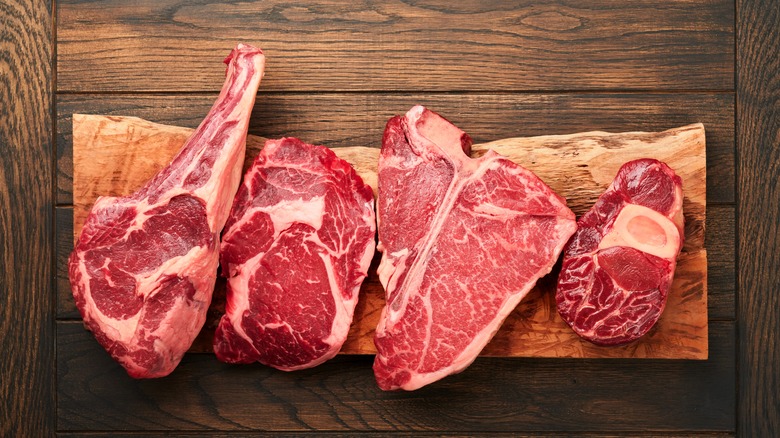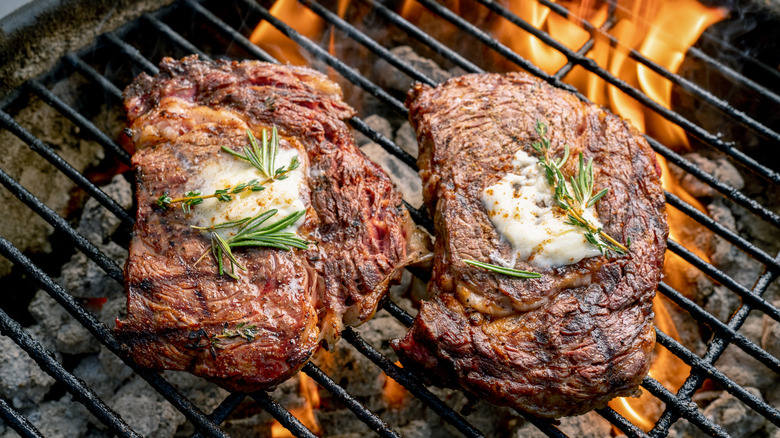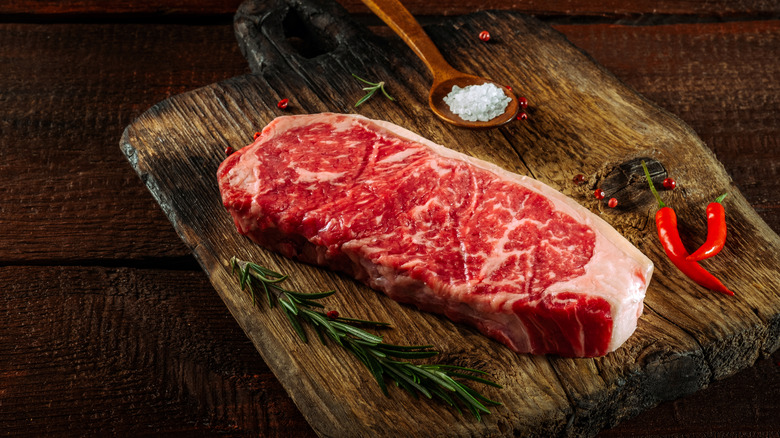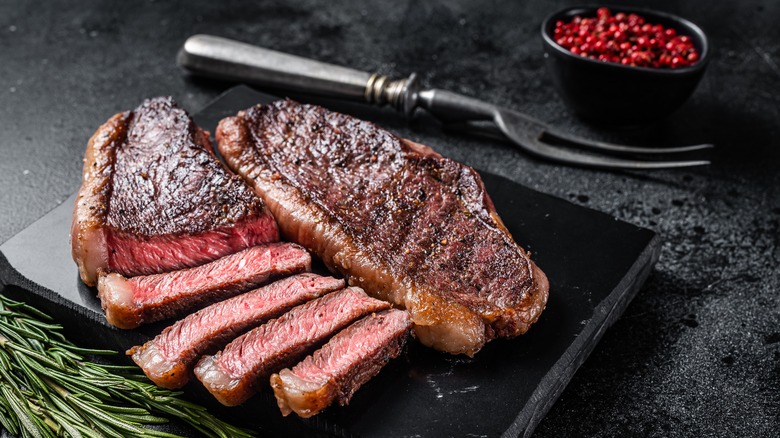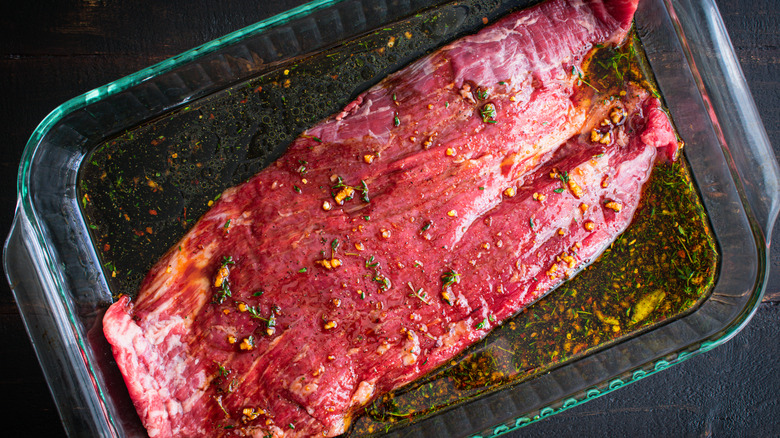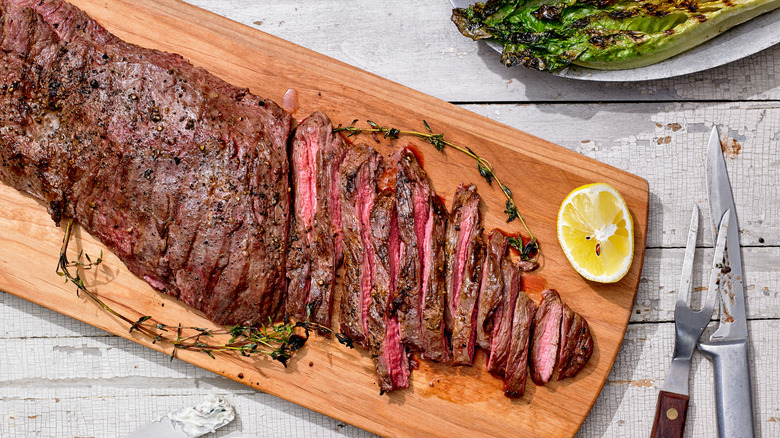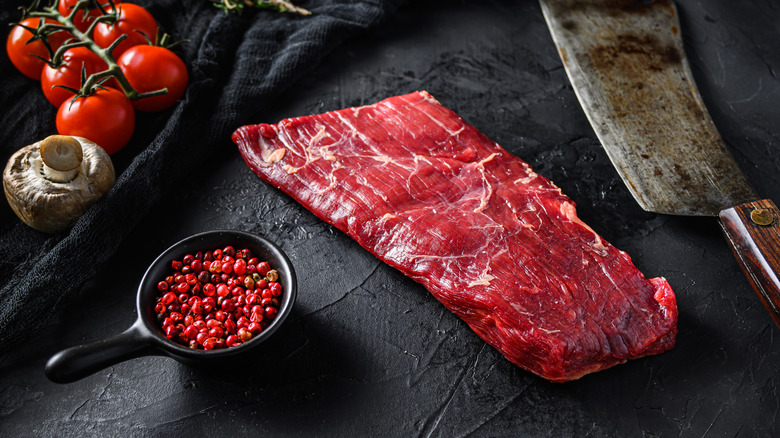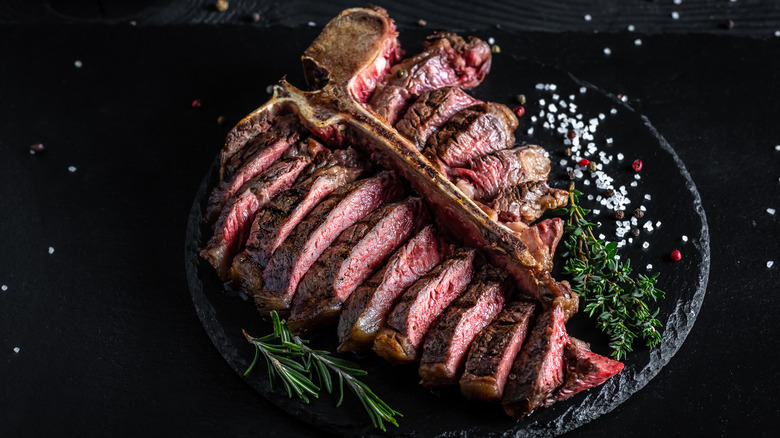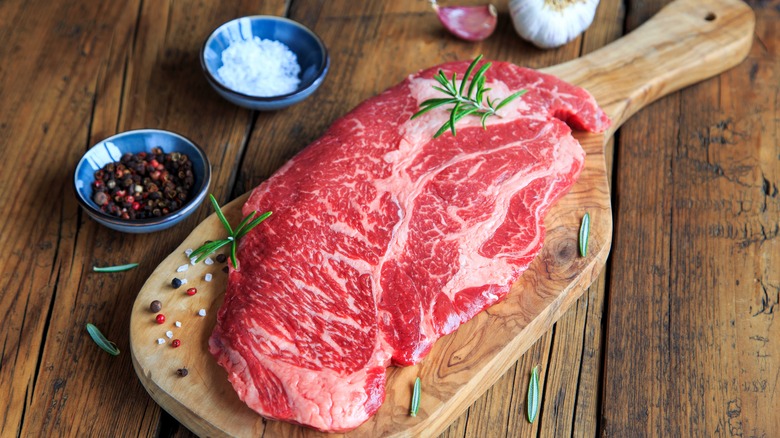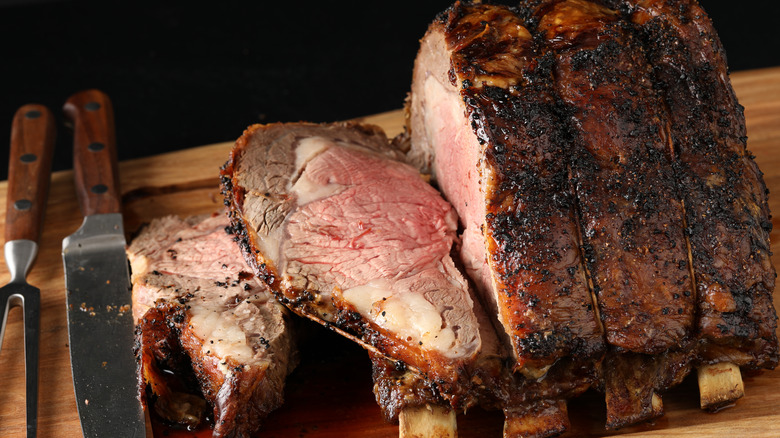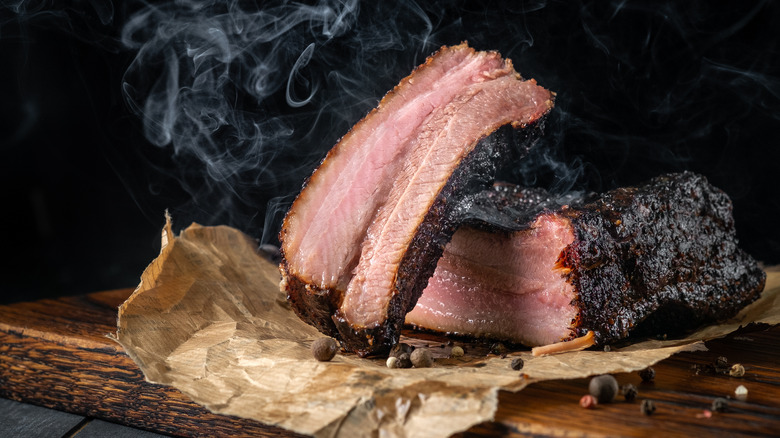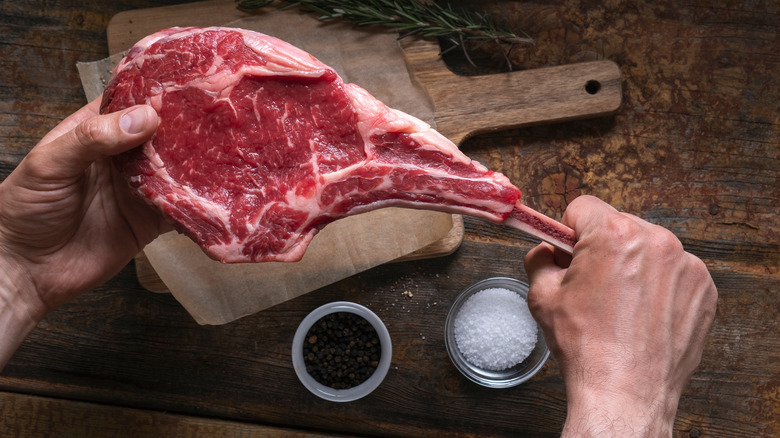12 Common Steak Cuts And The Best Way To Cook Them
For meat eaters, few meals are more satisfying than a perfectly cooked steak that's juicy, flavorful, and sizzling. Unfortunately, few meals can be as disappointing as a steak that's been overcooked and dried out. There are a few keys to getting your beef to its perfect level of doneness, and the most important of these is knowing what cut of steak you're working with.
One look at a beef cut chart and it's clear that there are dozens of different steak cuts available. From the large primal "basic" cuts — chuck, loin, round, rib, flank, brisket, short plate, and shank — come a variety of steaks with names you've likely heard of and eaten at some point: tenderloin, ribeye, T-bone, and the like. When it comes to cooking temperatures, methods, and times, not all these cuts are created equal. What coaxes out the flavor and juiciness in a ribeye could turn a filet mignon into a brick. So how do you prevent disappointing (and potentially expensive) steak-cooking mishaps when cooking up these classic cuts? We've got the answer for you below.
1. Filet mignon
The filet mignon is the creme de la creme of steaks: a luxurious, higher-end, special-occasion cut that melts in your mouth if done right. This small, succulent cut of steak comes from the tenderloin portion of the loin primal cut, a section found below the cow's backbone. The loin doesn't get much exercise, if any at all, so the steaks that come from it tend to be notably lean. This is good news for anyone trying to lower dietary fat but bad news for a home chef with a tendency to overcook their meat; filets dry out easily when cooked beyond medium-rare.
When it comes to cooking methods, versatility is one of the many charms of the filet mignon. Grilled, sous vide, or on the stovetop are all viable options. However, our favorite method is to pan sear on the stove to give the steak a gorgeous caramelized crust before finishing it in the oven at 350 F. Aim for an internal temp of 130 F, a juicy medium-rare.
2. Ribeye
The ribeye is a cut of steak beloved for its unparalleled meaty flavor. Coming from the rib primal on the cow's center back, a ribeye is almost the opposite of a filet mignon in terms of fat content. You'll find rich, flavorful marbling throughout these steaks (as with any sub-primal cut from the rib area), making them perfect candidates for a variety of cooking methods. Ribeye steaks can be pan-fried in a skillet or broiled, but grilling is the classic way to cook this cut. Either a gas grill or a charcoal grill does the job expertly, though a charcoal grill gives the beef extra flavor.
Whichever method you opt for, sear both sides of the meat for 1 to 2 minutes on the hottest section of the grill before moving to medium heat for the remainder of the cooking time. For the utmost in juiciness, aim for medium-rare. To achieve this, grill a 1-inch steak for 9 to 12 minutes, flipping the steak about a minute before the halfway point.
3. New York strip
When it comes to flavor for price, few steaks are as all-round easy to love as a New York strip. This steak cut hails from the same underused loin primal muscle group as the filet mignon, giving it that tell-tale tenderness that makes loin cuts so popular. Unlike the filet, which comes from the tenderloin, the New York strip is sourced from the strip loin. This translates to a steak that's a bit denser than a filet, though still relatively easy to chew. It also means you'll often find a literal strip of fat running along the edge of the steak. In fact, it's the quantity of marbling (another name for fat on a steak) that makes a New York strip such an everyday favorite. There's enough fat to provide the beefy flavor and texture you won't get in a filet mignon, but there's less marbling in a New York strip than in a ribeye — good news for anyone looking for a slightly leaner cut of beef.
Start a New York strip with a nice pan sear and finish it either in the oven or under the broiler, keeping your meat thermometer handy to avoid overcooking. The grill is another option that yields juicy, flavorful results or, if the steak isn't too thick, you can also just pan-fry it in your cast iron skillet. Either way, you'll want to use higher heat for a strip steak to avoid drying it out.
4. Top sirloin
Depending on who you ask, top sirloin is either an inherently disappointing cut of beef or a wrongfully maligned underdog (undercow?) deserving much more culinary respect than it gets. The controversy mostly stems from where it comes from on the cow: Top sirloin is cut from the underused loin primal area, home to the beloved filet mignon, so its leanness sets you up for a tough, dry meal if you overcook it. When top sirloin is cooked properly, however, it's tender and juicy, with a good beefy flavor — the tenderest of all the sirloin cuts, actually.
Top sirloin is one of those versatile steaks that works in an array of recipes. Serve it for breakfast next to eggs, or cut it up for sticky soy steak bites or kebabs. Whatever you do — and we can't stress this enough — the best way to support its potential for juicy tenderness is to keep it around medium-rare. Anything above that and you could be putting in a lot of chewing. Marinating for up to 8 hours is also an option for extra flavor and tenderness. For the best flavorful results, sear top sirloin in a cast iron skillet or crank up the grill. Aim for an internal temp of 125 F before removing the steak from the heat and setting it aside for 8 minutes.
5. Flank steak
If you've ever noticed that some steaks have lines or grooves running across the flesh, you've met one or more of the cuts that come from the underside of the cow. Flank steak is cut from the lower abdominal region below the upper abdominal plate primal. It is easily recognized by its thinness and the thick grain running lengthwise across the meat — those are the "lines" or grooves that set it apart from the smoothly marbled meat of other cuts. Always slice against the grain on cuts like this for easiest-to-chew results.
Flank steak is the go-to beef for dishes that call for slices: bowls, stir-fries, fajitas, tacos, and the like. Ribeye or sirloin would do the trick in these "busy" dishes, too, but flank meat has the added benefit of being more cost-effective. This is mostly due to its lack of tenderness. Typically, any of the steak cuts sourced from the cow's underbelly are going to be lean and tough, and flank meat is no exception. This is why tenderizing marinades make an appearance when flank steak is on the menu. The longer in the marinade, the better. Think 12 hours or so, though you could get away with six to eight. Pan-fry, grill, or broil the meat quickly over high heat, and aim for medium-rare.
6. Skirt steak
Thin, delicate, and lean with a lot of chewy connective tissue, skirt steak comes from the plate primal, the upper abdominal region of the cow. This cut gets its name from the appearance of its loose, crosswise grain, which some imaginative soul once likened to a pleated skirt. Skirt steak and flank steak are respectable substitutes for each other, but skirt steak is actually the first choice among many foodies for recipes like kebabs and fajitas because of its higher degree of marbling and flavor.
As with flank steak, marinating is the key to coaxing the most juice and tenderness out of skirt steak, but beware of marinating too long. These highly grained muscle fibers are more absorbent than those of flank steak; 30 minutes to an hour is all you need. Another difference that will inform your cooking: Since this cut contains more fat than a flank steak, it can be taken up to medium, though it's better at medium-rare. Whether you grill or pan-sear the meat, do it fast, and make sure the internal temperature hits 130 F. This is the temp where skirt steak's muscle fibers break down for best tenderness.
7. Flap steak
Flap steak, otherwise known as sirloin bavette, stir-fry meat, or bottom sirloin butt, often gets confused with a number of other cuts. It's in the same family as flank and skirt steak when it comes to its fibrous, grained texture and lack of overall tenderness, but it isn't cut from either the plate or the flank primal. It's also not the same as hanger steak or sirloin tips, though it's commonly mislabeled as such.
Flap steak comes from inside the belly at the bottom of the sirloin cut, next to the narrow end of the flank. It's an extension of the porterhouse and T-bone, which are also cut from this area. Like skirt steak, flap meat has a more bold, beefy flavor compared to flank steak, but it's thinner and more budget-friendly. If prepared and sliced correctly (against the grain, as with flank or skirt meat), it's perfect in fajitas and stir-fries. It goes without saying that marinating is a must for this cut — give it 6 hours in the marinade. Once that's done, grill or broil your flap steak without slicing it first, and stick to medium-rare.
8. Porterhouse or T-bone
Both of these recognizable cuts consist of two steaks: a filet and a New York strip. Coming in at 20 to 24 ounces, the porterhouse is the same steak as a T-bone but with a more generous filet portion. The porterhouse makes a great meal to share between two or more people, while a hungry diner can often polish off a T-bone alone. Both cuts come from the short loin, behind the rib primal and above the flank.
Grilling is the classic way to cook a porterhouse or T-bone steak. Cook either cut on a hot grill for 2 to 3 minutes. Rotate the steak 45 degrees and keep cooking on the same side for another 2 to 3 minutes. Flip and repeat. After letting the meat rest for 5 to 10 minutes, slice it crosswise toward the bone on both sides, and voila! You've got a meal as succulent as it is picture-worthy.
9. Chuck eye steak
Chuck eye steak comes from the back of the chuck primal cut — the shoulder region. These muscles are well-used, so cuts from this primal are on the tough side. Chuck eye steak is another of those beef cuts that goes under a variety of names: Delmonico steak, boneless chuck filet, and English steak. It's also known by the rather tasteless nickname "the poor man's ribeye," which gives you an idea of its value for money and robust beefy flavor. Cut from the fifth rib of the cow, the chuck eye steak is a close neighbor of the ribeye, which is sourced from the sixth through 12th ribs.
Like the cut it's sourced from, the chuck roast, chuck eye steak quickly reaches dried "shoe leather" status if overcooked. The solution: Treat it like a more finicky ribeye. Sear it on the grill over high heat for 2 minutes per side. Drop the heat to medium-low and cook for 2 to 3 more minutes for medium-rare or 3 to 4 minutes for medium.
10. Prime rib
Before we go into what prime rib is, let's talk about what it's not: The "prime" in the name is not related to the USDA grades of beef. It's also not the same as a USDA prime ribeye steak. The prime rib, also known as a standing or prime rib roast, is a well-marbled, sizable, tender cut sourced from the rib primal (one of the potential origins of the name).
In its standard form, prime rib is very large, consisting of six ribs with an eye of meat in the center. That central eye, where the meat is cut away from the bone, is the choicest cut from the prime rib because of its flavor and tenderness. It's also the spot that ribeye steaks come from. A whole six-rib prime rib steak is a lot to work with, but it's perfect for feeding a group. Otherwise, when buying prime rib, it's possible to have your butcher remove the bones or slice you off a piece with fewer of them, making it more manageable for home cooking.
The best way to cook prime is with a reverse sear. Season the meat, being careful not to salt it too early, and roast it to rare or medium-rare in a covered roasting pan. Remove the steak from the oven and let it rest for 15 minutes to an hour. To achieve that perfect sear, put it back in the oven uncovered at 550 F for around 7 to 8 minutes.
11. Brisket
Cookout staple and a must on the table for several Jewish holidays, brisket may not technically be "steak," but it's an incredibly common beef cut with incredibly specific cooking needs. It comes from the brisket primal, the cow's lower pectoral muscles. This area gets a lot of exercise, and working muscles correspond to tough cuts of meat that need a low and slow cooking approach to break down their tough connective fibers and collagen. High-heat grilling is the wrong approach when cooking brisket.
If you've got the first cut/flat cut, braise or cook your brisket in the oven. If you've bought a second cut (or deckle point), smoking is the way to go. To keep the meat from getting tough in the smoker, use the 3-2-1 method. This involves smoking the meat for three hours uncovered, wrapping it in foil for the next two hours of cooking, and then finishing the last hour off unwrapped. The result is tender, juicy brisket that melts in the mouth.
12. Tomahawk (bone-in ribeye)
The tomahawk steak takes everything we love about ribeyes — marbling, flavor, tenderness — and turns up the intensity. This cut is immediately recognizable for its 8-to-12-inch rib bone that gives it the shape of a tomahawk ax. Aside from just looking awesome, tomahawk ribeyes are large and thick, with a heftier price tag than other steaks. The cost is also due to the skill and time required to properly French the rib bone, which involves trimming away the meat and fat.
Since these steaks are large and over 2 inches thick, your typical quick sear on the grill or in a skillet won't do it. Reverse searing a tomahawk steak is the best bet, and there are a few ways to achieve this. For an indoor/outdoor method, salt the meat and let it sit for 12 hours to a day. Next, season the steak and cook it in the oven for about 40 minutes at 200 F while you heat a grill to medium-high. When your meat thermometer registers the ideal level of doneness, finish the steak on the grill with about 2 to 3 minutes per side.
